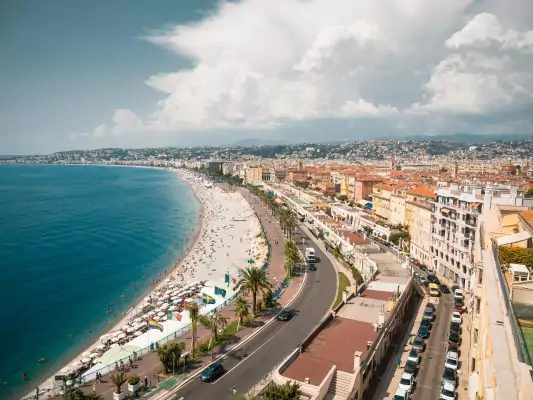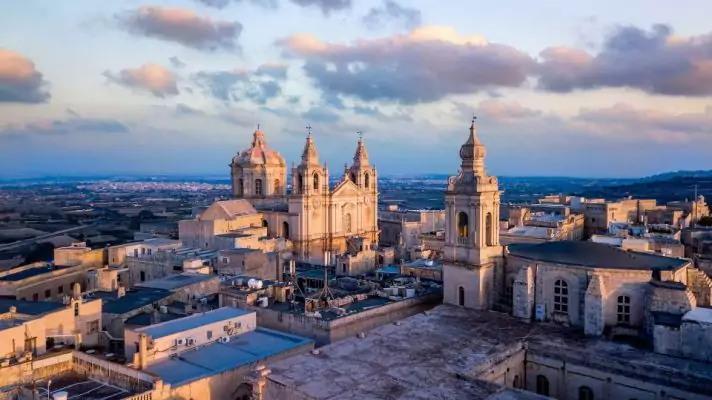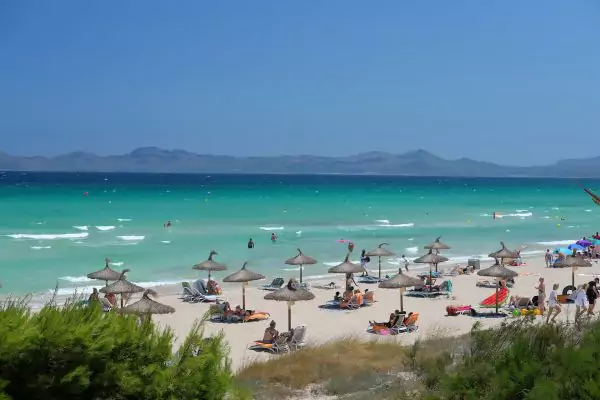Japan 8-Day Itinerary – What to See and Do in One Week

Best things to see and do in Japan in one week. Discover the country’s most famous landmarks and tourist hotspots in our Japan 8-day itinerary!
This Japan 8-day itinerary is a part of our broader travel guide for the country. We recommend you check it out for the best travel tips and the most accurate information on transportation, hotels, restaurants and best hikes in Japan.
Japan 8-Day Itinerary – Where to visit in Japan in 1 week
Well, there’s no point in sugarcoating it – 8 days in Japan is too short for anyone keen on exploring the Land of the Rising Sun. However, if one week is all you have and you’re determined to visit this legendary destination, we’re here to help you make the most of your experience. To do so, you’ll need to keep up the pace, even if you only end up visiting the “essentials”, such as the vibrant capital of Tokyo and the ancient imperial capital of Kyoto, saving up some precious time for the classic day trips to Mount Fuji, Nara and to the thrilling Universal Studios Japan. To make sure our original plan isn’t too restrictive, we’ll provide several different options for some days, allowing you to tailor the itinerary to your preferences.
That being said, if you are looking for more comprehensive itineraries and have some additional time in hands, feel free to have a look at our extended guides to Japan:
- Japan 12-Day Itinerary – Best Places to Visit in the Country
- Japan 16-Day Itinerary – Highlights of Two Weeks in Japan
So, without further ado, here are the cities, places and tourist attractions you should visit in an 8-day itinerary through Japan:
Japan 8-Day Itinerary: Day 1 – Tokyo: Shibuya, Harajuku and Shinjuku

After a good night of rest following a flight half-way across the world, it’s finally time to delve into the mesmerizing and captivating Japan. As expected, our journey begins in the massive city of Tokyo, the nation’s capital. Tokyo is a metropolis of contrasts, where bustling crowds, electronic billboards and loudspeakers clash with the silence, the serenity and the order. Despite its immense size, Tokyo is surprisingly easy to navigate and explore, and there’s no better place to gain a sense of that organized chaos than at the iconic Shibuya Scramble Crossing, globally known as the busiest pedestrian crossing on Earth. While it may seem odd how this kind of place became a tourist magnet to begin with, experiencing the bustling intersection firsthand is a must. Aside from joining the crowds on crossing the street, there are several viewpoints from which to watch the “show”. Alongside Shibuya Sky (¥2200), one of Tokyo’s most popular vantage points where tickets often sell out in advance (buy online here), you can also take in the views of the crossing from MAGNET by Shibuya 109 (¥1500, including a drink) or from the galleries of Shibuya Mark City. Regarding the latter, views may not be as impressive but at least admission is free.

From there, you’ll head north into the neighboring district of Harajuku. While the luxury shops lining Omotesando Avenue may initially dazzle you, Harajuku’s real subculture can be found at Takeshita Street. Despite its touristy reputation, this pedestrian thoroughfare is filled to the brim with alternative shops displaying the unique style that became synonymous with Harajuku. Think colorful wigs, lacy fabrics, extravagant makeup and quirky bows – as if the street has been suddenly taken over by the cast of “Sailor Moon”! For something way more sober, it’s time to pay a visit to Meiji Shrine, one of Tokyo’s most popular religious sites. Located inside a green space adjacent to Yoyogi Park, this shrine pays tribute to Emperor Meiji, the ruler who declared the end of the Edo period and reopened Japan to the outside world, leading to its remarkable industrialization and rise as one of the globe’s wealthiest and most advanced nations. Plus, this is also a great place to get introduced to Shinto, Japan’s native religion which is still practiced by the majority of the population. Despite having been heavily influenced and molded by Buddhism, Shinto still maintains its distinct rituals and sanctuaries. Next on our itinerary is Shinjuku Gyoen (¥500). In a city that is famous for housing some of the most beautiful parks in the world, this one might very well be the most spectacular of the bunch! Plus, this is one of the most popular places in all of Japan to witness the pink hues of the cherry blossom season.
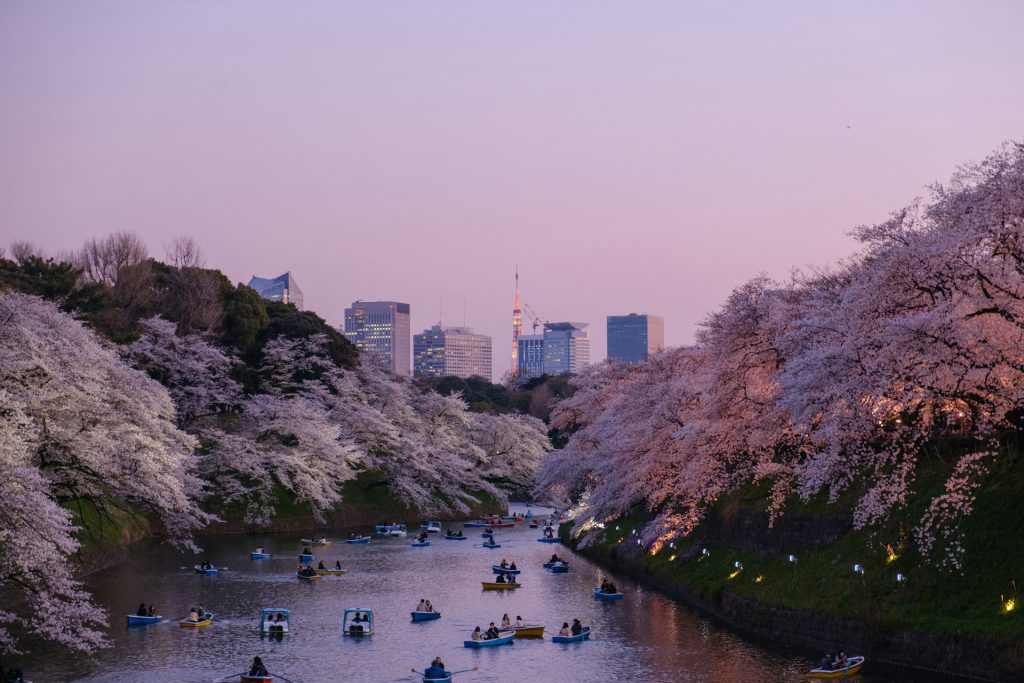
As the day comes to an end, and once the night falls over Tokyo, there’s no better place to be than Shinjuku. If you’ve dreamed of Tokyo’s stereotypical bright lights and bustling streets, this is where you’ll find them! In fact, there aren’t that many tourist attractions in Shinjuku, but simply strolling along its rowdy streets and taking in all the mayhem is part of the quintessential Japanese experience – like going to New York and seeing Times Square! For something a bit more local, we recommend strolling along Golden Kai, a street famous for its abundance of bars, or venturing into the atmospheric alleyways of Omoide Yokocho, weirdly nicknamed “Piss Alley”. Plus, this is one of the top places in Tokyo to indulge in a snack or two at an izakaya, a traditional Japanese pub where salarymen unwind after a long day’s work. Finally, and in order to gain a better insight into how unbelievably sprawling Tokyo really is – this is the world’s biggest city, after all – don’t miss out on getting to the top of the Tokyo Metropolitan Government Building. While there are many other observatories in the city, some inclusively at higher altitudes, this is the only one where admission is free. Besides, you can even catch a glimpse of Mount Fuji on clear days! On a final note, if that view of Mount Fuji is a must for you, then simply reverse the order for the day, starting with the observatory in Shinjuku and ending the day at the iconic Shibuya Scramble Crossing, when crowds are even bigger.

First day wrap-up:
- Shibuya Scramble Crossing
- Shibuya Sky OR MAGNET by Shibuya 109 OR Shibuya Mark City
- Harajuku
- Takeshita Street
- Avenue Omotesando
- Yoyogi Park
- Meiji Shrine
- Shinjuku Gyoen
- Shinjuku
- Tokyo Metropolitan Government Building
- Yomode Okocho
- Golden Kai
Where to eat in Japan – Best restaurants in Shibuya and Shinjuku
- Tatsunoya (ramen)
- Ichiran Ramen (ramen)
- Sushiro (conveyor belt sushi)
- Uobei (conveyor belt sushi)
- Nabezo (shabu-shabu and sukiyaki – all you can eat)
- Niigata Katsudon Tarekatsu (tempura and tonkatsu)
- Torikatsu Chicken (karaage – Japanese fried chicken)
- Hayashiya (omurice and omubargu)
- Saitama ya (izakaya)
- Ucchan (izakaya)
- Flipper’s (kiseki – fluffy pancakes)
Japan 8-Day Itinerary: Day 2 – Tokyo: Ginza, Chiyoda, Akihabara and Ueno

For your second day in Tokyo, you’ll get out of bed early in the morning and check out some of the other city districts, starting at the famous Tsukiji Fish Market. Once the place where the iconic morning tuna auction took place – an event many tourists made sure to witness – now only the outer market remains, where you can find countless street stalls offering all kinds of local delicacies (though predominantly focused on fish and seafood). Unsurprisingly, this is where some of Japan’s finest sushi and fish bowls (kaisen donburi) are offered, albeit at prices substantially higher than average. Nevertheless, it’s a cool place for a stroll and to sample a few new things. Once you’re done with the market, follow that up with a visit to the district of Ginza, renowned as one of Tokyo’s most upscale and exclusive areas. A place to see and be seen! Though there’s not much to see or do in Ginza when it comes to conventional tourist landmarks, a walk down Chuo Dori – the central avenue – and a visit to the Kabukiza Theater are highly recommended. Playing host to some of the most famous plays of Kabuki, a traditional Japanese style of performing arts, these musical numbers can easily last over 4 hours per show. While understanding the dialogue may pose a challenge for non-Japanese speakers, the theater offers ¥1000 “single act tickets” for those curious to experience a single segment of the play (approximately 60 minutes).

At the western edge of Ginza, you will come across the Tokyo Imperial Palace Gardens. While the palace itself remains closed to the public except on specific festive occasions, it’s still very much worth exploring the surrounding gardens and enjoying distant views of the buildings’ architecture. Even if you go ahead and book a guided visit that allows you to actually enter the islet where the main palace is located, keep in mind the interiors are always off-limits. A few kilometers northward (you can walk or take the JR Yamanote Line), and the path will now lead you to Akihabara, Tokyo’s epicenter of nerd and geek culture, and a stark departure from the traditional sobriety of Japanese society. Here, anything goes! We’re talking about dozens of multistory buildings brimming with manga and video game stores (some selling 20th century classics), sex shops, pachinko and slot parlors, and all kinds of weird themed cafes your mind can think of, from the harmless joints where you can share the space with cats, owls or capybaras, to the far more suggestive maid cafes (where waiters dress up as French maids…), to the downright bizarre restaurants featuring BDSM, dancing robots and screaming samurai. Definitely a different side of Tokyo!
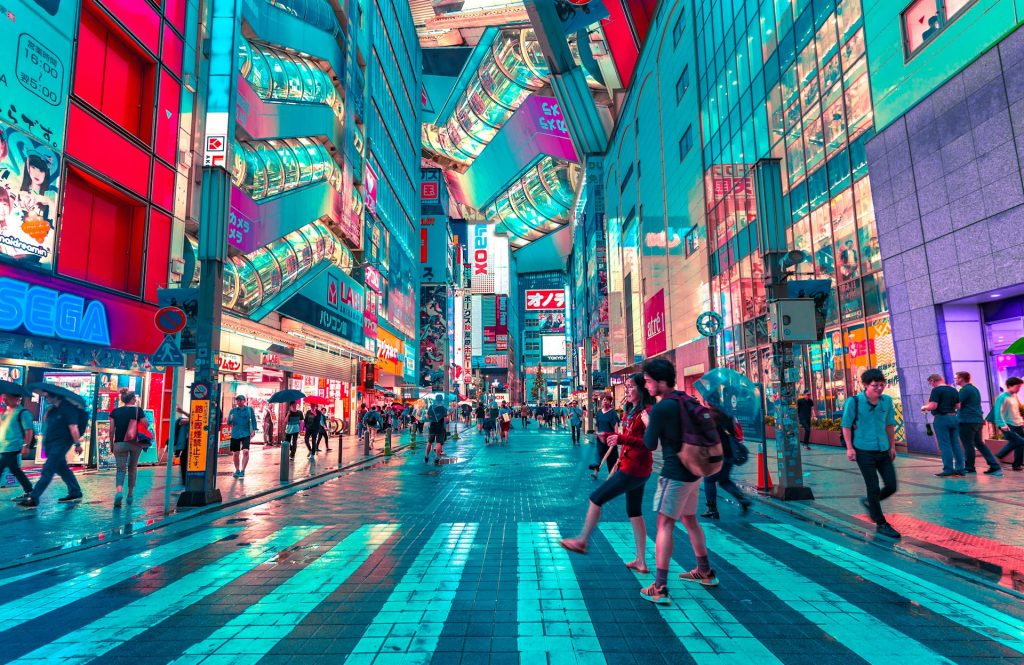
As hunger sets in, you’ll take your well-deserved lunch break at the Ameyoko Shopping District, one of Tokyo’s biggest street food hubs, before venturing into the nearby Ueno Park. Much like Shinjuku Gyoen, this park is also a great place to witness the cherry blossom season, though it remains a timeless tourist attraction all-year-round, boasting the likes of the Ueno Toshogu Shrine (¥500) and the Tokyo National Museum (¥1000). Split across six different buildings, the latter is home to the country’s biggest collection of archaeological and cultural artifacts. Finally, you’ll cap off this busy day with a visit to Senso-ji Temple, Tokyo’s oldest and most important Buddhist sanctuary. Beyond its impressive architecture, which includes the iconic Kiminarimon Gate and Five-Storied Pagoda, the complex is also famous for Nakamise Street.
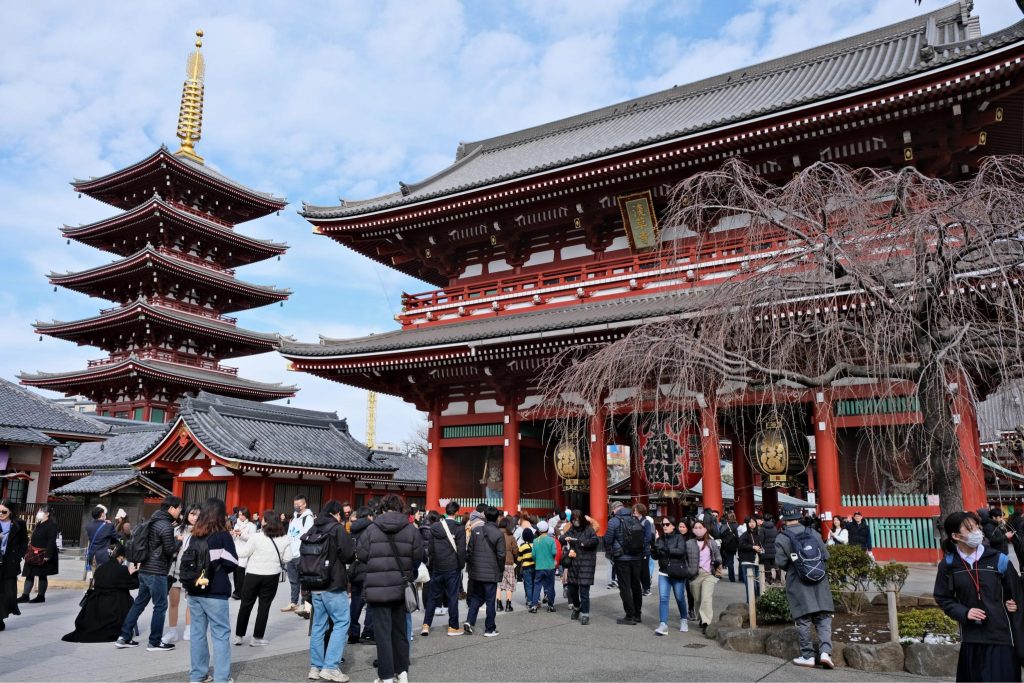
Second day wrap-up:
- Tsukiji Fish Market
- Ginza
- Chuo Dori
- Kabukiza Theater
- Tokyo Imperial Palace Gardens
- Akihabara
- Ameyoko Shopping District
- Ueno Park
- Ueno Toshogu Shrine
- Tokyo National Museum
- Senso-ji Temple
- Nakamise Street
Where to eat in Japan – Best restaurants in Ginza, Ueno Park and Asakusa
- Tsukiji Fish Market (fish, seafood and wagyu beef)
- Yoroiya (ramen)
- Yukikage Asakusa (ramen)
- Owariya (soba noodles)
- Fukutei (Japanese curry)
- Bistro Fukushotei (katsu curry and omurice)
- Ginza Shabutsu (shabu-shabu)
- Chanko-Beya Asakusa (chanko nabe – hot pot for sumo wrestlers)
- Minatoya (kaisen donburi – bowls of rice and raw fish)
- Tempura Abe (tempura)
- Tsurujirō (okonomiyaki)
Japan 8-Day Itinerary: Day 3 – Day Trip to Mount Fuji
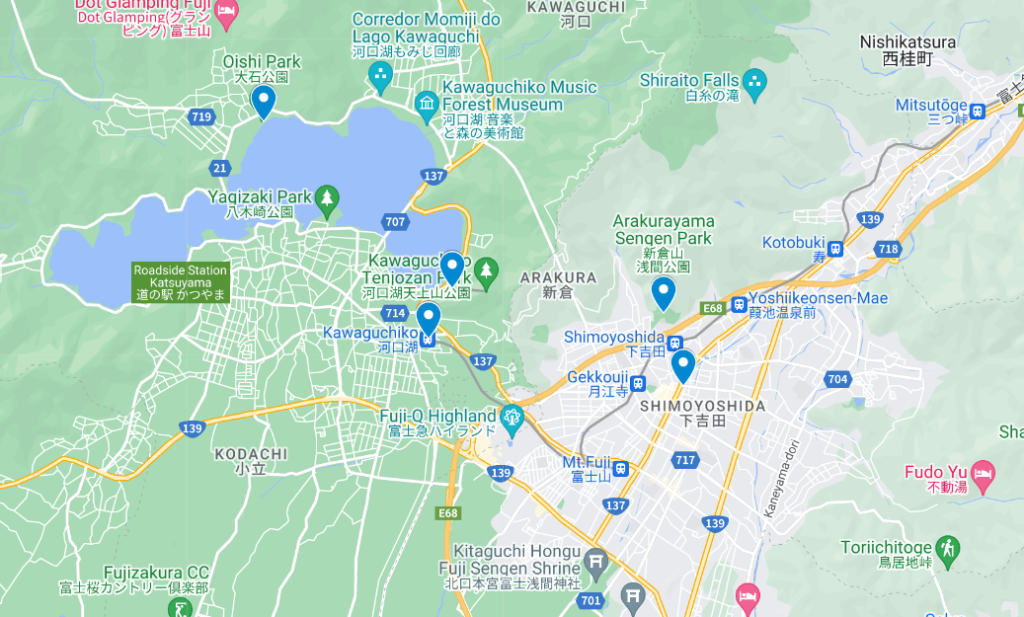
Magnificent, majestic, breathtaking. Is there a more quintessential image of Japan than the snow-capped summit of Mount Fuji? W ell, today you’ll have the chance to witness it firsthand! While there are several towns and regions where you can appreciate the sight of the iconic volcano, most visitors gravitate towards two specific regions: Hakone and the Fuji Five Lakes. In our case, we’ll suggest a visit to the latter, particularly to Lake Kawaguchi. To go from Tokyo to Kawaguchi Station, you can hop on a train from JR, specifically the Ltd. Exp. Fuji Excursion service departing from Shinjuku. This line links the the capital to Mount Fuji in just over 90 minutes, with a one-way ticket priced at ¥4130. Alternatively, for a budget-friendlier option, consider JR Kanto buses (refer to our Japan general guide for schedule information and tickets), which complete the journey in about 2 hours, costing ¥2050 for a one-way trip. Additionally, since many attractions near the lake are quite spread out, you’ll have to rely on local buses and trains (Fujikyu Railways).
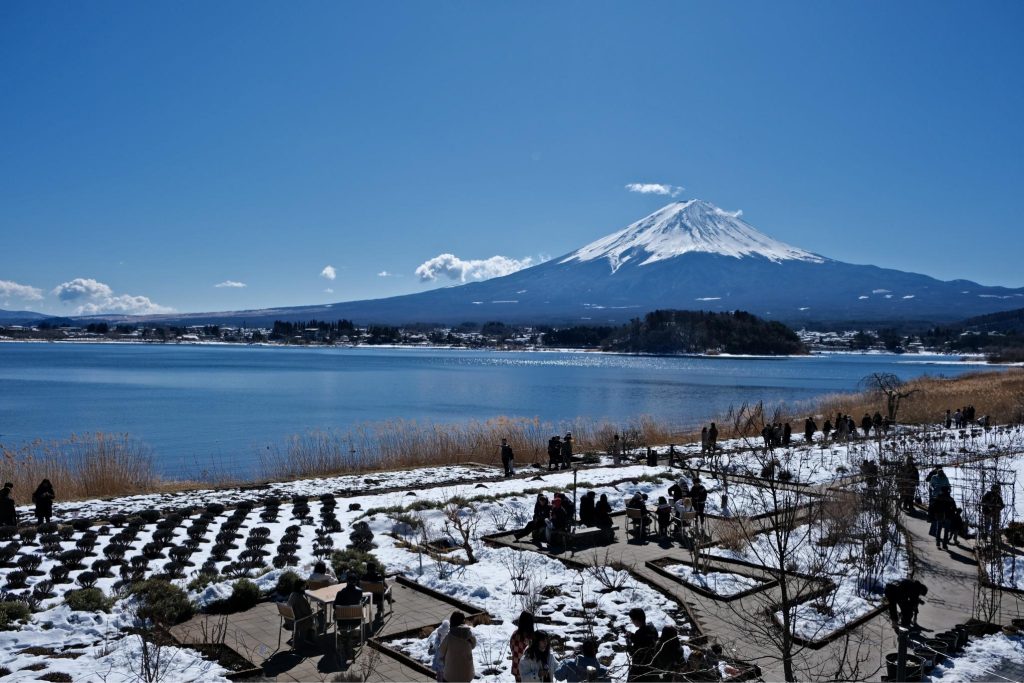
With that said, let’s kick off our itinerary with a visit to Oishi Park, on the northern shores of Lake Kawaguchi. Famous for being the best spot along the lake for admiring Mount Fuji’s iconic beauty, Oishi Park is a must-visit. To get there, board the red line of the local bus system, departing from stop nº 1 of the tiny terminal located directly in front of the Kawaguchi train station. You can conveniently use your Welcome SUICA or PASMO Passport to pay for the fare (¥570, 30 minutes). After snapping some of those mindboggling photos, hop back on the same bus, this time in the opposite direction, and get out at the stop called Yuransenropulei-iriguchi (¥470, 15 minutes), conveniently located by the entrance of the Mount Fuji Ropeway (¥900 round-trip). This panoramic cable car offers a brief journey to the summit of the Kawaguchiko Tenjozan Park, boasting a scenic terrace with absolutely stunning views. To the right, the serene Lake Kawaguchi; to the left, the majestic silhouette of Fuji – can’t get any better!

Back on solid ground, you’ll walk for 15 minutes until you’re back at the train station. Once you’re there, you can board the Fujikyu Railways line and get off at Shimoyoshida (¥310), the starting point for the brief yet rewarding 400-steps climb to the iconic Chureito Pagoda, part of the Arakura Sengen Shrine. Funny enough, the pagoda itself isn’t particularly grand or impressive, but the way its silhouette stands against the backdrop of Mount Fuji is nothing short of mesmerizing – and one of Mount Fuji’s most emblematic postcard-pictures. As the time comes for you to start slowly making your way back to Tokyo, consider a brief detour to the lesser-known Shimoyoshida Honcho Street, another hidden gem where you can capture Fuji’s majestic peak. To return to the capital, simply catch the local train back to Kawaguchiko (¥310), then board either a bus or train bound for the capital. On the other hand, if you find yourself with some extra time to spare, and depending on your interests, then you might consider visiting the Fuji-Q Highland amusement park, soaking at the Fujiyama Onsen’s hot springs or embarking on a scenic cruise along Lake Kawaguchi aboard the Appare Boat. Nevertheless, if you’re able to stick to our original plan, we guarantee it will be a day well spent!

Third day wrap-up:
- Lake Kawaguchi
- Oishi Park
- Mount Fuji Ropeway
- Chureito Pagoda
- Shimoyoshida Honcho Street
Where to eat in Japan – Best restaurants in Kawaguchiko
- Ramen Kaneyuki (ramen)
- Miyaki (udon noodles)
- Hotokura Funari (hoto noodles)
- Fuji Tempura Idaten (tempura)
- Sumibi Yakiniku Himawaritei (yakiniku – Japanese bbq)
Japan 8-Day Itinerary: Day 4 | Option 1 – Tokyo: Day in Kamakura / Night in Roppongi
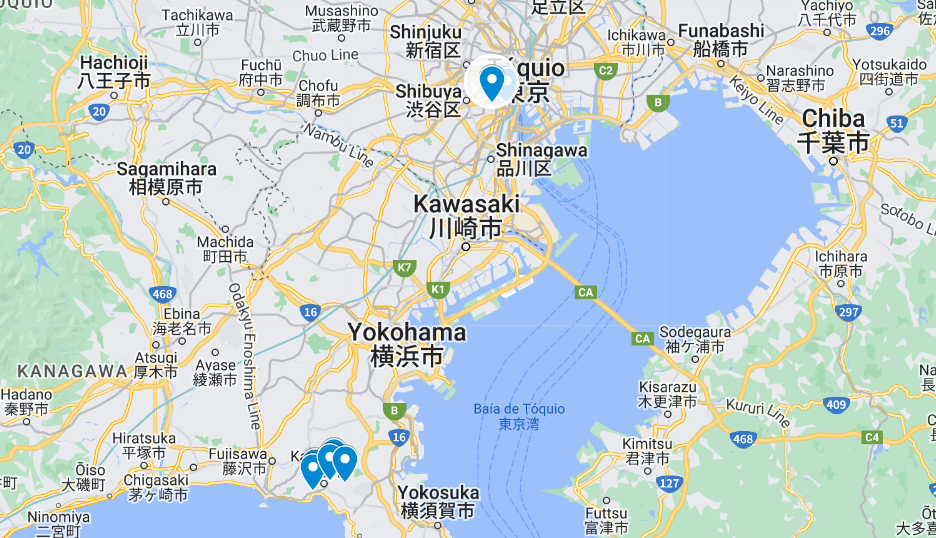
Now that you’ve been able to visit (well, sort of) Tokyo’s major tourist areas – as well as the colossal Mount Fuji – you’ll dedicate your last day in the capital to exploring at least one other neighboring town. Perhaps the easiest day trip from Tokyo, you can opt to visit the ancient historic capital of Kamakura. This city is just a 60-minute train ride from Tokyo, with several direct local services per hour (via the JR Shonan-Shinjuku Line) departing from Shinjuku, Shibuya or Tokyo Station. The ticket costs ¥940 one-way. Important note: You can use the lockers available at any of these stations (¥300, ¥500 or ¥700, depending on size) to store your luggage, as you’ll be spending the night in a different city. To make the best use of your time, it’s good to know that Kamakura also has its own networks of trains (Enoshima Electric Railways) and buses. So, if you wish to save your legs and some precious time, we recommend taking the round trip (5 minutes each way, ¥400 round trip) between Kamakura Station and Hase Station, which is closest to the first two temples on this itinerary.

As for Kamakura, known as the “Little Kyoto”, it was struck by a massive earthquake in 1923 that nearly destroyed all its historical areas. However, the city’s phenomenal array of temples mostly survived unscathed, still adorning the landscape between the hills and the sea to this day. In total, there are around 80 temples and shrines in Kamakura, so you’ll need to be highly selective if you intend to return to Tokyo in time for the recommended late afternoon activities. With that said, we suggest starting with a mandatory visit to Hase Temple (¥400), famous for its immaculate gardens, terrace overlooking the sea and the beautiful main building, which houses an impressive wooden statue of the goddess Kannon standing over 9 meters tall! Nearby, you can also find the Great Buddha of Kamakura. Located inside Kotoku-in Temple (¥300), this famous bronze statue is arguably the most iconic symbol of Kamakura, and for an additional ¥50 you can even enter its small interior. When you’re ready to return to the main station (as mentioned in the previous paragraph), you’ll stroll along Komachi Street and visit the Tsurugaoka Hachimangu Shrine, the most important Shinto place of worship in the city. Before catching the train back to Tokyo, we also recommend making one last effort and stopping by Hokokuji Temple. Although the temple itself is rather ordinary, its backdoors hide one of the most beautiful private gardens (¥400) in Japan, famous for its small bamboo grove.
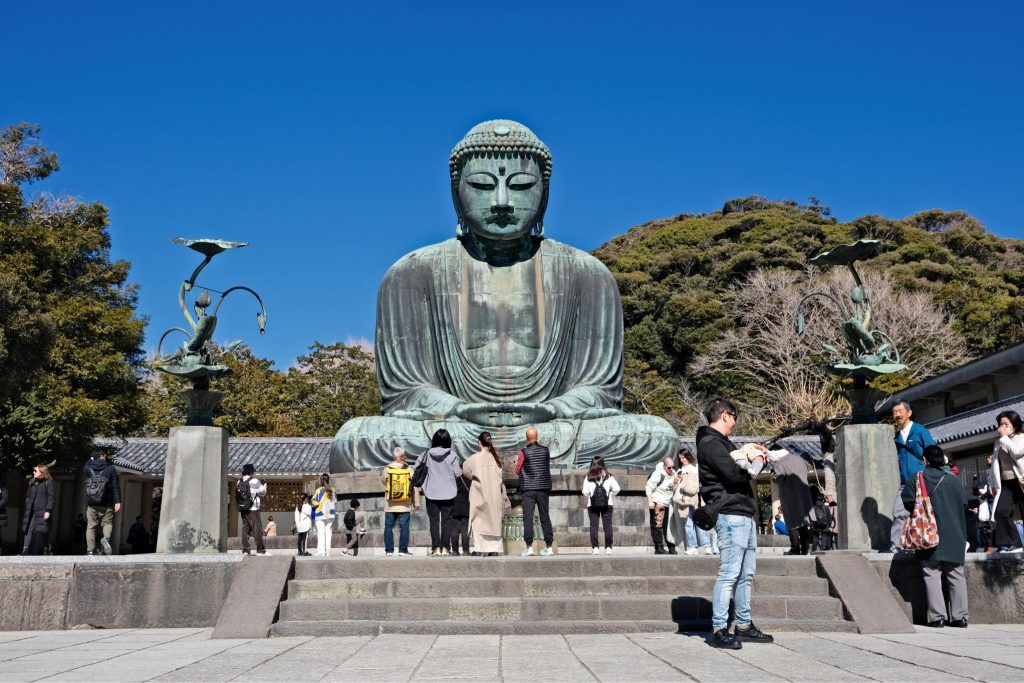
Back in Tokyo, you’ll end your afternoon with a visit to teamLab Borderless (¥3800), one of the world’s best digital art exhibitions. Located inside the Mori Digital Art Museum, part of the Azabudai Hills complex, this experience is a true festival of color, sounds, holograms and mirror reflections, and one of the most impressive things to grace Instagram feeds around the world. In fact, it poses the question: Is this place truly “art”? Or is it just a great marketing strategy for people seeking highly aesthetic photos and videos? We’ll leave that for you to decide. Please note that purchasing tickets online is mandatory and should be done well in advance, as you’ll need to specify the date of your visit and a 30-minute arrival window. However, and as long as you enter the museum within that timeframe, you can stay for as long as you like. As the night sets in, and since you’ll be nearby anyway, you can enjoy another panoramic view of Tokyo by climbing up the famous Tokyo Tower (¥1200 for the Main Deck at 150 meters; ¥3000 for the Top Deck at 250 meters), the former tallest building in the city before the Tokyo Skytree was inaugurated. Alternatively, for a view that includes the Tokyo Tower itself, you can access the observation deck at Tokyo City View (¥2000). When you’re ready to leave Tokyo, and after collecting your luggage, it’s time to make the journey to Kyoto. In order to optimize your brief time in the country, it’s best to take the Shinkansen departing from Tokyo Station. The journey will be quite costly (¥13,500) when compared to the bus or local trains, but at least it won’t take too much of your precious time, getting you to Kyoto in just over 2 hours.

Fourth day wrap-up | Option 1:
- Kamakura
- Hase Temple
- Great Buddah of Kamakura
- Komachi Street
- Tsurugaoka Hachimangu Shrine
- Hokokuji Temple
- teamLab Borderless
- Tokyo Tower OR Tokyo City View
Where to eat in Japan – Best restaurants in Kamakura and Roppongi
- Kamakura Mitsui (Japanese set meal)
- Wasai Yakura (Japanese set meal)
- Narutoya + Tenzo (Japanese set meal)
- Afuri (ramen)
- Ippudo (ramen)
- Sushi Masa (sushi)
- Kajiya (kaisen donburi – bowls of rice and raw fish)
- Butagumi Shokudo (tonkatsu)
- Akimoto (tempura)
- Onari Yokocho (vegetarian)
Japan 8-Day Itinerary: Day 4 | Option 2 – Day Trip to Nikko

On the other hand, if you wish to spend the whole day outside Tokyo and prefer a combination between nature and cultural sightseeing, we’ll venture away from the bustling city towards Nikko National Park, one of the most popular weekend getaway destinations among Tokyo locals. Before heading to Nikko, you’ll want to make use of one of the many lockers at Asakusa Station (ranging from ¥300 to ¥700, depending on size) to store your luggage, as you’ll be spending the night on a different city. Since there are no direct buses to Nikko, your transportation options are limited to trains, with services provided by both JR and Tobu Railways. However, we recommend going with the latter, as they offer the Nikko Pass World Heritage Area. In addition to covering the base fare for trains between Asakusa and Nikko, this pass includes unlimited bus transportation within a designated area in Nikko. It costs ¥2120. Unfortunately, though, there’s more to it when it comes to travel expenses. Since this pass only covers the base fare for the trip, it means you can only rely on local trains if you don’t want to spend any more money. However, doing so would require 4 hours of travel and some 5 transfers, making it pretty much impossible to visit Nikko on a day trip. Therefore, in addition to the pass, you’ll need to pay a limited express fee (a mandatory seat reservation on fast trains) for Tobu’s Limited Express trains, which shorten the journey to just 2 hours. For a round trip between Tokyo and Nikko, this fee amounts to ¥3300, bringing the total transportation cost for this day trip to ¥5420. You can purchase the pass on the day of your trip at the Tobu Tourism Information Center in Asakusa or online through this link, although you’ll still need to collect it in person at the same location. On the other hand, reservations for the limited express train must be made at least a couple of days in advance. You can do this through Tobu’s online reservation system (Departing station: “Asakusa”; Arriving station: “Tobu-Nikko”) or by visiting Asakusa station a few days prior.

Now that we’ve tackled the logistical details, let’s talk about what to see and do in Nikko – famous for its breathtaking waterfalls, scenic trails and numerous temples and shrines, recognized as UNESCO World Heritage Sites. Among these, the most prominent is the monumental Nikko Toshogu Shrine (¥1300), arguably the finest in all of Japan. Serving as the final resting place of Tokugawa Ieyasu, the ruler who kickstarted the Edo period and played a pivotal role in the unification of Japan, this shrine is a curious departure from the traditional simplicity of Japanese religious sites. No more sobriety or humbleness, as this temple boasts a juggernaut festival of gold, opulent architecture and vibrant colors. Plus, it’s also famous for blending elements of both Buddhism and Shinto (extremely uncommon in Japan), and for housing the first-ever depiction of the “Three Wise Monkeys” (hear no evil, speak no evil, see no evil). Nearby, you can also find the other two popular temples of Nikko: the Futarasan Shrine (¥200) and the Rinnoji Temple (¥400). However, after visiting the Toshogu, nothing else can quite compare! As you descend the hill, be sure to visit the iconic Shinkyo Bridge (¥300) before returning to the station. Back in Tokyo, and after collecting your luggage, it’s time to make the journey to Kyoto. In order to optimize your brief time in the country, it’s best to take the Shinkansen departing from Tokyo Station. The journey will be quite costly (¥13,500) when compared to the bus or local trains, but at least it won’t take too much of your precious time, getting you to Kyoto in just over 2 hours.
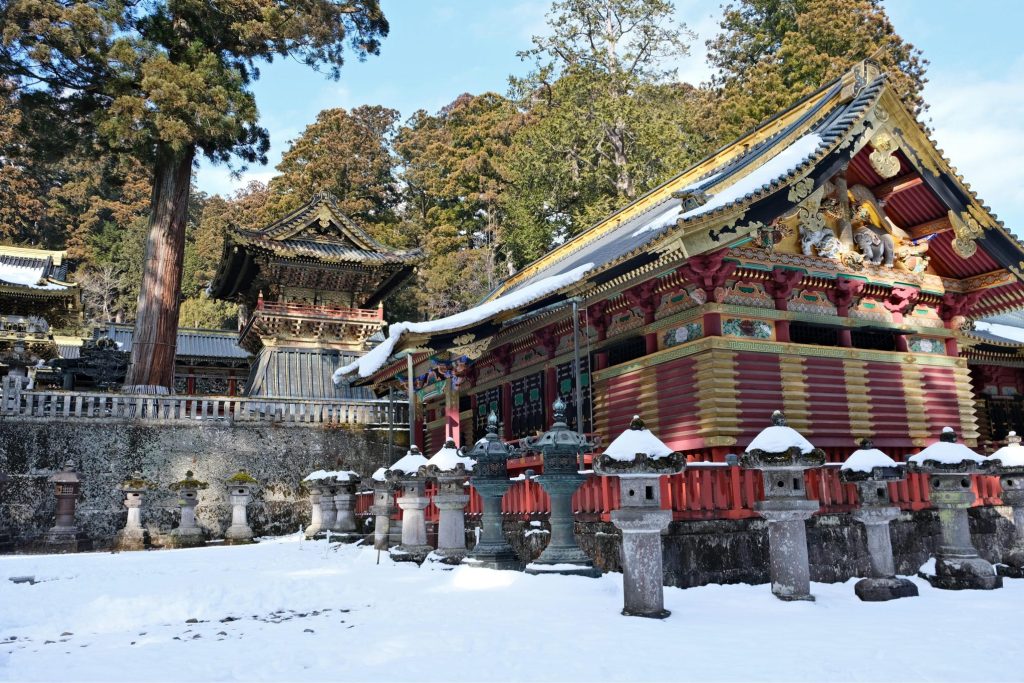
Fourth day wrap-up | Option 2:
- Nikko Toshogu Shrine
- Futarasan Shrine
- Rinnoji Temple
- Shinkyo Bridge
- Ryokan Experience at Hotel Shoho Matsumoto
Where to eat in Japan – Best restaurants in Nikko
- Ramen Bonten (ramen)
- Gyoza-No Umechan (ramen and gyoza)
- Numataya (sushi)
- Ranburu (yuba – Nikko’s local tofu skin)
- Yakimen Akinoya (yakisoba)
- Tonkatsu Asai (tonkatsu)
- Yonekichi Akira Sushi (sushi and yuba)
Japan 8-Day Itinerary: Day 5 – Kyoto: Gion and the Temple District

After a good night of sleep, today promises one of Japan’s most iconic itineraries. Kyoto stands out as the nation’s most revered tourist destination, so there is plenty to see and do in the ancient imperial capital, especially when it comes to the historic district of Gion and the region of Northern Higashiyama, home to the Temple District. That being said, your day will start precisely with a visit to one of Kyoto’s three most famous temples/shrines: the Kiyomizu-dera Temple. While access to the gates and to the Zuigu-do Hall is free, you’ll need to pay a small fee of ¥500 to enter the Hondo (main building), the Okuno-in Hall and to see the charming Otowa Waterfall. Plus, the paid area is where you’ll find the panoramic terraces offering breathtaking views of the Hondo’s deck, the temple’s most emblematic image – and an experience not to be missed! Following your visit to the temple, you’ll stroll along the enchanting Sannenzaka and Ninenzaka streets, arguably the prettiest thoroughfares in the city, where you can get a glimpse of old Kyoto and snap great pictures of the Yasaka Pagoda.
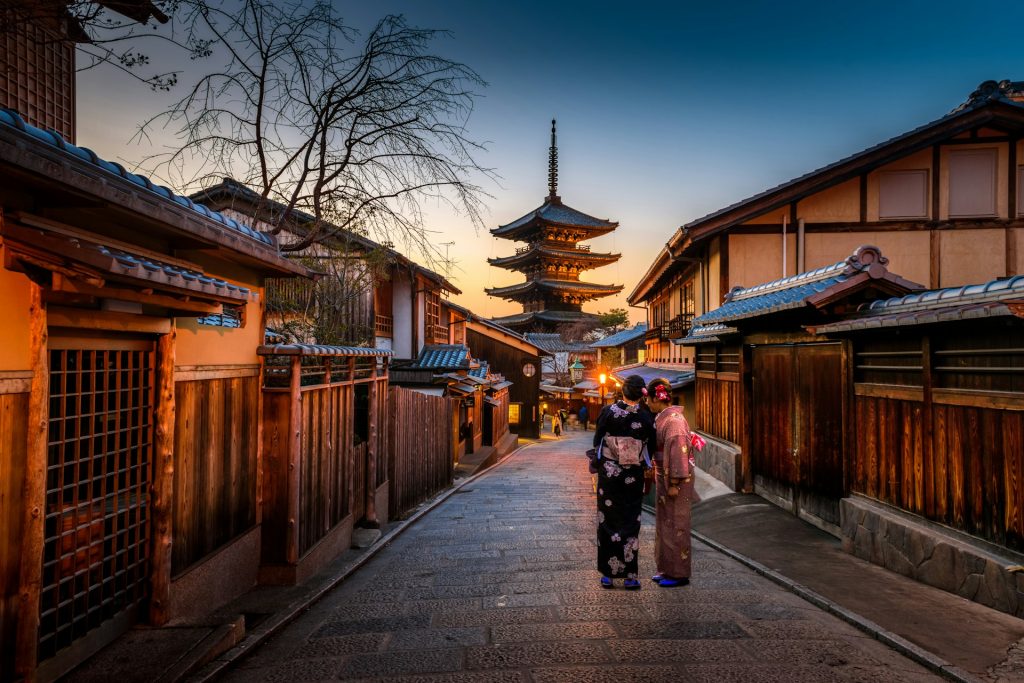
From there, you’ll keep heading north until you reach Kodai-ji Temple (¥600). While its buildings may not rival those of other temples in Kyoto, this one actually boasts a lovely garden with a pathway through its very own bamboo grove. On the other hand, your next stop – Kennin-ji Temple (¥600) – may lack expansive traditional gardens, but its spectacular main hall adorned with a monumental painting of two dragons stretching across the ceiling is certainly a sight to behold. Besides, as the temple once served as a monastery of Zen Buddhism, visitors can also explore the living quarters where monks resided and carried out their daily activities. Afterwards, you’ll finally venture into Gion, historically known as the Geisha District. To this day, it remains home to numerous ochayas (teahouses) where local geishas continue to entertain with traditional tea ceremonies and Japanese arts performances. Although Gion is traditionally referred to as an “Old Town” of sorts to Kyoto, the truth is that the district is relatively modern, especially if you try to compare it to its European counterparts. Be that as it may, glimpses of old Japan can still be found along some of the quarter’s streets, such as Hanamikoji Street, Shirakawa Lane, Pontocho Alley or Isibekouji Street.
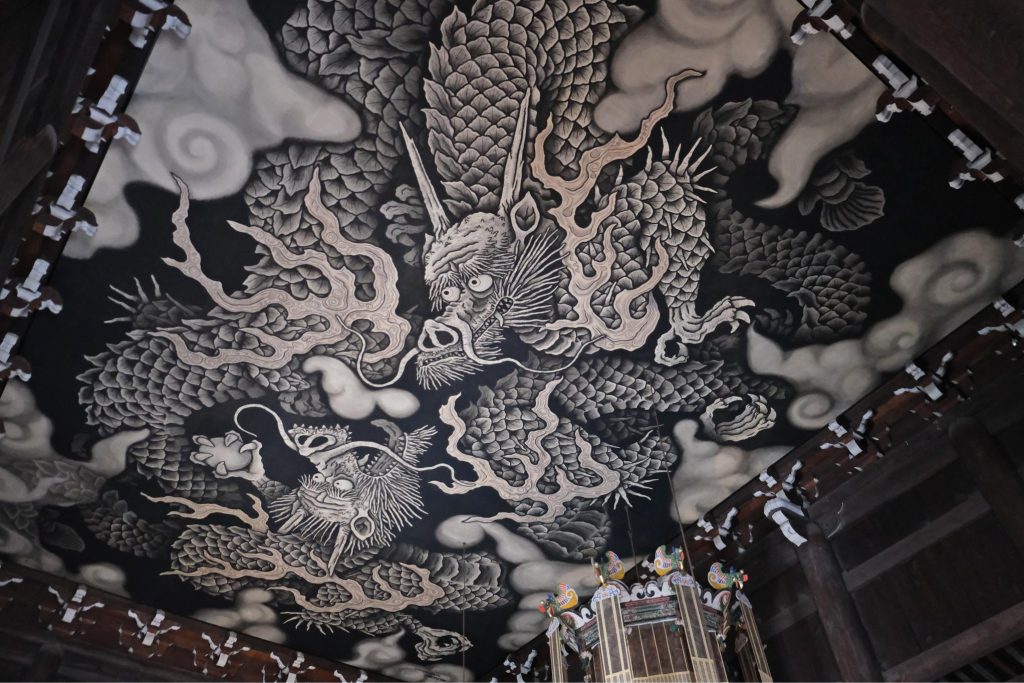
After lunch, don’t miss out on Nanzen-ji Temple. While the main temple building (¥400) isn’t all that impressive, the grounds feature the impressive Sanmon Gate, one of Kyoto’s largest and most imposing gates. For an additional ¥500, visitors can ascend to the top of the gate for panoramic views of the surroundings. However, what really lands Nanzen-ji Temple a spot on our itinerary is the unusual presence of a 100-year-old-aqueduct inside the complex, built to help supply water to a nearby canal. As the afternoon unfolds, your journey through Northern Higashiyama’s temples will continue along the picturesque Philosopher’s Path. Starting in the Nanzen-ji quarter, this scenic 2-kilometer trail is filled with cherry blossoms, making it a prime destination during the Sakura season. If you’re visiting during a different time of the year do not be discouraged, as this walk along the banks of the Lake Biwa Canal is a pleasant experience all-year-round along. At the end of the trail, you’ll finally come across Ginkaku-ji Temple (¥500), famous for housing the Silver Pavilion. Beyond the iconic structure though, the temple’s most distinctive feature is its lush moss garden (sounds weird, but it’s extraordinarily beautiful), that you can explore before retreating back to your hotel room.
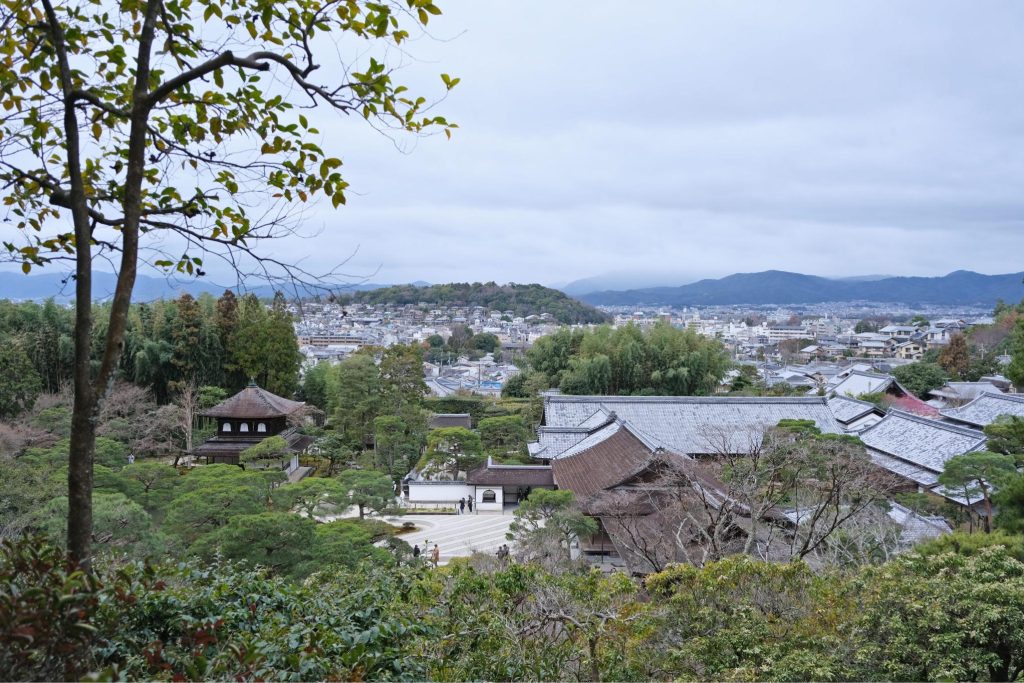
Fifth day wrap-up:
- Kiyomizu-dera Temple
- Sannenzaka Street
- Ninenzaka Street
- Yasaka Pagoda
- Kodai-ji Temple
- Kennin-ji Temple
- Gion Quarter
- Hanamikoji Street
- Shirakawa Lane
- Isibekouji Street
- Pontocho Alley
- Nanzen-ji Temple
- Philosopher’s Path
- Ginkaku-ji Temple
Where to eat in Japan – Best restaurants in Higashiyama
- Oshokuji Dokoro Asuka (Japanese set meal)
- Udon Main (udon noodles)
- Mimikou (udon noodles)
- Yagura (soba)
- Aburasoba Nekomata (soba)
- Teppanyaki Manryu (teppanyaki – iron griddled meat, fish and vegetables)
- Gyoza Hohei (gyoza)
- Karako (karaage)
- Hisago (rice bowls and noodles)
- PIZZERIA da NAGHINO (pizza)
Japan 8-Day Itinerary: Day 6 – Kyoto: Fushimi Inari and a Day Trip to Nara

Remember when we said that regardless of the time you had in the country, you’d always have to pick up the pace? Well, today is an excellent example of just that, as you’ll have only one day to explore neighboring Nara and still save a few hours to visit the most famous temple in all of Kyoto (perhaps even Japan). Famous for the countless vermilion torii gates lining the pathway from the main shrine to the top of Mount Inari, Fushimi Inari Shrine is an absolutely iconic site and, alongside Mount Fuji and Himeji Castle, one of the main postcard pictures when it comes to promoting tourism in the Land of the Rising Sun. The hike to the mountaintop can take nearly 3 hours (round-trip), a timeframe we simply cannot dispose of for this day, which is why we suggest going only as far as the Yotsutsuji Crossing, a “mere” 60 to 90 minutes (round-trip) away from the start of the trail. From there, you’ll be able to enjoy a nice view of Kyoto, having had the opportunity to explore some secondary shrines and walk through endless rows of picturesque vermilion gates. Since you have a long day ahead and crowds can be quite overwhelming at this shrine, we recommend visiting Fushimi Inari at the break of dawn, one of the rare instances where you can experience the trail in silence and at your own pace. Although not exactly close to central Kyoto, access to the shrine is quite easy, as you can simply take a JR Nara Line train from Kyoto Station (get off at Inari) or the Keihan Main Line from Gion (get off at Fushimi Inari). In both cases, the ticket will cost around ¥250, and you can use your IC card (PASMO or SUICA) for payment.

Moreover, this destination combo for today works because you don’t need to return to central Kyoto to head to Nara. Instead, you can simply return to Inari Station, board the JR Nara Line again and travel to Nara Station, with the journey taking 1 hour and costing ¥700. Aside from being Japan’s first permanent capital, a glorious period that left behind some of the world’s most impressive Buddhist temples, Nara is famous for its massive deer population. Regarded as messengers of the gods according to Shinto beliefs, native deer in Nara have always been allowed to coexist among humans, with the local species adapting and developing the habit of being surrounded by people. As you walk through the vast Nara Park, the city’s main green space, you’ll encounter dozens and dozens of deer, as if you’ve just walked into the set of a Disney film. Everywhere, you’ll also find street stalls selling rice crackers (¥200 per pack), the only snack tourists and locals are allowed to feed the animals. Although it’s possible to feed the deer, take photos and even pet them, keep in mind that these are still wild animals, so there’s always a certain level of risk involved.

In addition to the expansive park, other notable sites in Nara include the spectacular Kofuku-ji Temple (¥700), featuring its Central Hall and Five-Story Pagoda, and the Isuien Garden (¥1200). However, the only landmark in Nara capable of rivaling the magic of the deer is the jaw-dropping Todai-ji Temple (¥600), whose centerpiece – the Great Buddha Hall – stands as the world’s largest wooden building. Speaking of superlatives, the hall’s interior also houses Japan’s largest Buddha statue, making the one in Kamakura look like a trinket. Definitely one of the most striking buildings you’ll see in Japan. Behind Todai-ji, you’ll also find some wooden buildings that are actually sub-complexes of the temple, such as Nigatsudo Hall. Finally, you’ll continue your journey across Nara Park until you reach Kasuga Taisha Shrine (¥500), the last temple for the day. Surrounded by dozens of deer and about 3000 stone lanterns that line the path to the entrance of the shrine, this is one of Japan’s most magical sights, and a place that actually resembles the Japan we’ve heard and read about on movies and books! On the way back to the station for the return trip to Kyoto, be sure to stop by Nakatanidou, Japan’s most famous mochi shop. If you’ve come across the funny clips of two men shouting and pounding green dough on social media, chances are that video was filmed here. That said, you can always come, watch the brief “show” and try a mochi made in the most old-fashioned way possible. While the combination of matcha-flavored glutinous rice and sweet red bean filling may not sound the most appealing thing in the world, it’s undoubtedly the most Japanese combination in human history!

Sixth day wrap-up:
- Fushimi Inari Shrine
- Nara
- Nara Park
- Kofuku-ji Temple
- Isuien Garden
- Todai-ji Temple
- Nigatsudo Hall
- Kasuga Taisha Shrine
- Nakatanidou
Where to eat in Japan – Best restaurants in Nara
- Tenkaippin (ramen)
- Sushi Ichi (sushi)
- Kamaiki (udon noodles)
- Surugamachi’s Okonomiyakiya (okonomiyaki)
- Kizuna Café (omurice, Japanese curry and katsu)
- Kinari Pizza (pizza)
- Nakatanidou (mochi)
Japan 8-Day Itinerary: Day 7 – Kyoto: The Golden Pavilion, Arashiyama e Downtown Kyoto
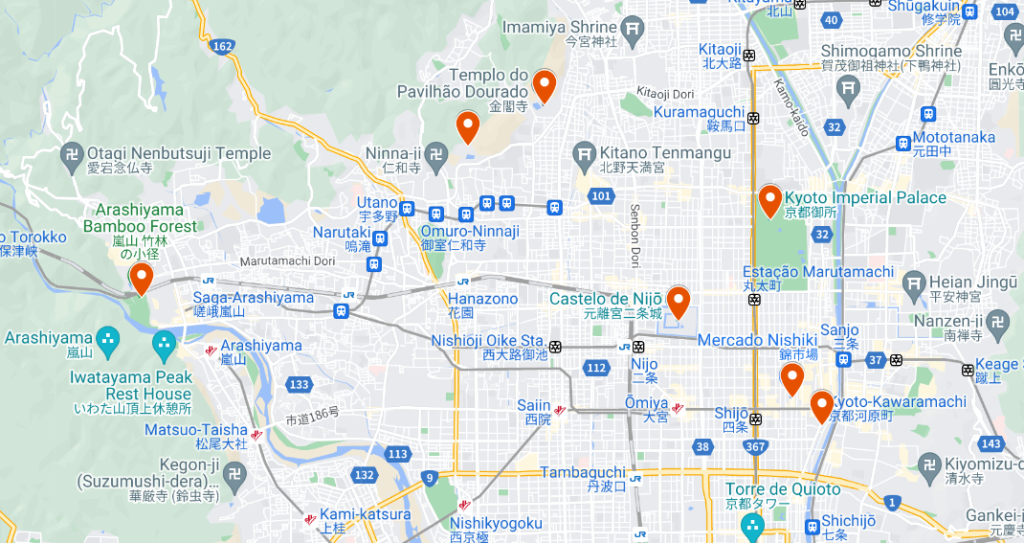
Before bidding farewell to Kyoto, you’ll dedicate one last full day to the city and take the opportunity to visit its remaining tourist districts, including the bustling modern area of Downtown Kyoto and the last element of the city’s three main temples. In fact, let’s get right to it! Now that you’ve visited Kiyomizu-dera and Fushimi Inari, the “Big Three” are complete with a visit to Kinkaku-ji Temple (¥500). Since this area of the city is not served by the metro or the train (the nearest station is Kitano Hakubai-Cho, located over 20 minutes away on foot), your best bet is to take the bus. You can use lines 12 (from Gion), 204 (from Northern Higashiyama) or 205 (from Downtown Kyoto and Kyoto Station). Although it’s the smallest temple of the three, Kinkaku-ji boasts the most beautiful building in the entire city – the iconic Golden Pavilion. In fact, its name shouldn’t be taken figuratively, as the façade is literally covered in gold leaf. It is absolutely stunning! After visiting the temple, you’ll walk about 1.5 km to Ryoan-ji Temple (¥600), known for having one of the world’s most famous “dry gardens”. In this type of garden, no trees or plants are used, and the space is adorned with nothing but stones, sand and gravel. It may not really fit into the garden aesthetics you’re probably used to, but its layout has a deeper meaning. Comprising 15 stones scattered across a small gravel field, it’s impossible to see all 15 elements at once from the main deck, no matter how hard you try. The only way to see all stones at once is by standing on a higher platform, symbolizing spiritual ascension.

From the temple, you’ll head to Ryoanji Station and board the Kitano Line from Keifuku Electric Railroad towards Katabiranotsuji Station. Then, you’ll transfer to the Arashiyama Line (from the same company), and get off at Arashiyama, the final station. You can use your IC Card to pay for the trip (¥250). As you may have guessed from the name, the final stop is located near the Arashiyama Bamboo Forest, another one of Kyoto’s most popular sites. If you’ve followed our itinerary so far, then by now you will have visited one or two small bamboo groves. However, nothing compares to the sheer size of this forest, with various trails and paths flanked by the towering plants. Although you won’t have much time left, if you want to visit more cool places in Arashiyama, you can also stop by Tenryu-ji Temple (¥800 for the temple + garden; ¥500 for the Dharma Hall) or by the Iwatayama Monkey Park.

To get back to the city center and visit Downtown Kyoto, you’ll again hop on a train from the Arashiyama Line and leave at the terminus in Shijō-Ōmiya (¥250). From there, you’ll walk for about 1km until you get to Nijo Castle (¥800), the former official residence of the Shogun in Kyoto. Although Japan retained the Emperor as its head-figure, the Shogun was the one who actually held the power during the Edo Period, and it was precisely inside this castle that the regime eventually came to an end. Fearing a military defeat, the reigning Shogun declared the restoration of formal power to the Emperor, marking the end of an era in Japan. Since this historic episode reopened Japan to the outside world, leading to its steady industrialization, we can confidently say that the country would be very different from the one we know and love today if that document – signed inside this castle – had never been proclaimed. History aside, this is the castle with the most beautiful and well-preserved interiors in all of Japan, and it’s well worth the ticket price (which also includes access to all the gardens in the complex). Finally, your day will come to an end with a visit to the Kyoto Imperial Palace, the Emperor’s official residence until 1868. However, keep in mind that, much like the palace in Tokyo, it’s mandatory to schedule your visit in advance, otherwise you won’t be allowed inside the walls of the palace and your visit will be restricted to the grounds of the Kyoto Gyoen National Garden. Once you’re done with all the sightseeing, it’s time to look for something to eat at the always lively Nishiki Market, before taking a nighttime stroll through the district of Kawaramachi. With its tall buildings, loud music, bustling crowds and insane number of bars and restaurants, this is the area of Kyoto that will remind you that, despite its gardens, temples and historic districts, this is still a city of 1.5 million people.

Seventh day wrap-up:
- Kinkaku-ji Temple (Golden Pavilion)
- Ryoan-ji Temple
- Arashiyama Bamboo Forest
- Tenryu-ji Temple
- Iwatayama Monkey Park
- Nijo Castle
- Kyoto Imperial Palace
- Kyoto Gyoen National Garden
- Nishiki Market
- Kawaramachi District
Where to eat in Japan – Best restaurants in Downtown Kyoto
- Mercado Nishiki (market)
- Ootoya (Japanese set meal)
- Ippudo (ramen)
- Ramen Sen-no-Kaze (ramen)
- Shabu-Shabu Tajimaya (shabu-shabu)
- Gyukatsu Kyoto Katsugyu (katsu)
- Kara-Kusa Curry (Japanese curry)
- Wakasaya Kawaramachi (kaisen donburi)
- Nishiki Warai (okonomiyaki)
- Daikichi Horikawa Takatsuji (izakaya)
Japan 8-Day Itinerary: Day 8 | Option 1 – Osaka

For your eight and final day in Japan, you’ll want to start early in the morning from Kyoto and complete the short train journey to Osaka, Japan’s second-largest city. There are several local services available, both from JR and other private companies (like the Keihan Main Line), that will get you to Osaka in less than 60 minutes, for a fare of around ¥400 to ¥600. Once again, just swipe your IC Card! Alternatively, if you want to take the Shinkansen, the journey lasts only 15 minutes but is also much more expensive (¥1440). For services originating from Kyoto, the final stations in Osaka will be Shin-Osaka, Umeda or Yodoyabashi. Upon arrival, we recommend leaving your luggage in one of the many lockers at any of these stations (these can cost between ¥500 and ¥1000) and setting out to explore the city. Osaka may lack the charm of Kyoto or the organized chaos of Tokyo, but it’s a city with tremendous character. It’s one of the few places in Japan where you might find litter on the ground, graffiti on the walls or pedestrians ignoring red lights when crossing the street. Let’s say Osaka is to Japan what Naples is to Italy or Marseille to France. It’s not for everyone, but it’s one hell of a ride!

With that said, you’ll immediately hop on the JR loop line (which passes through Umeda) and get out at Osakajokoen, the closest station to Osaka Castle (¥600). Although the castle is a reconstructed version of the original (like most castles in Japan), the park offers a welcome escape from the hustle and bustle of the big city. Next up, you’ll take the Tanimachi Line (purple) at Temmabashi, on the other side of the park, and travel to Tanimachi 9-chome, a short walk from Sumiyoshi Shrine. This Shinto shrine is one of the most beautiful in Osaka, though you’ll hardly be surprised by any other Japanese temples after visiting Kyoto. In fact, since Osaka is strongly hailed as Japan’s street food capital, temples and shrines are far from being the priority to visitors. In the more central areas, the concentration of restaurants, street stalls and izakayas is nothing short of overwhelming, and you’ll rarely go more than 30 seconds without seeing a window display or a menu offering the city’s specialties (such as okonomiyaki or takoyaki). For a first taste of this crucial element of local culture, we suggest a stroll through Kuromon Market, before diving headfirst into the sensory overload that is the district of Dotonbori.

It’s hard to put into words what goes on in Dotonbori. It’s a gigantic cluster of tall, modern buildings and covered shopping arcades, where each façade is adorned with billboards (like the famous Glico Running Man), neon lights and restaurant signs that, in the most extravagant cases, almost resemble amusement park rides. It’s contagious, even if in the worst way possible (for some). Still in Dotonbori, you’ll have to go for a walk along Shinsaibashi-Suji, the city’s main shopping street. After picking up your bags and completing the check-in, you’ll take a few hours to rest until night falls. Once the sun sets and Osaka lights up, you’ll head out and visit Harukas 300 (¥1800), the observation deck at Japan’s tallest building. Although the way to get there will depend on the location of your place of accommodation, the closest stop to the towering building is Tennoji Station. As expected, the view is absolutely jaw-dropping and will give you a better sense of just how big Osaka really is. Back on the ground, it’s worth stopping by the Tsutenkaku Quarter. Once considered one of the ugliest and most dangerous districts in the city, things have changed since the 2000s. Crime is no longer an issue, but Tsutenkaku has never lost that aura of degradation and seediness, a world away from the Japan you’ve met so far. Still, a very cool place for your last dinner in the country, since you’ll have to get back to Tokyo the next day, where your return flight awaits.
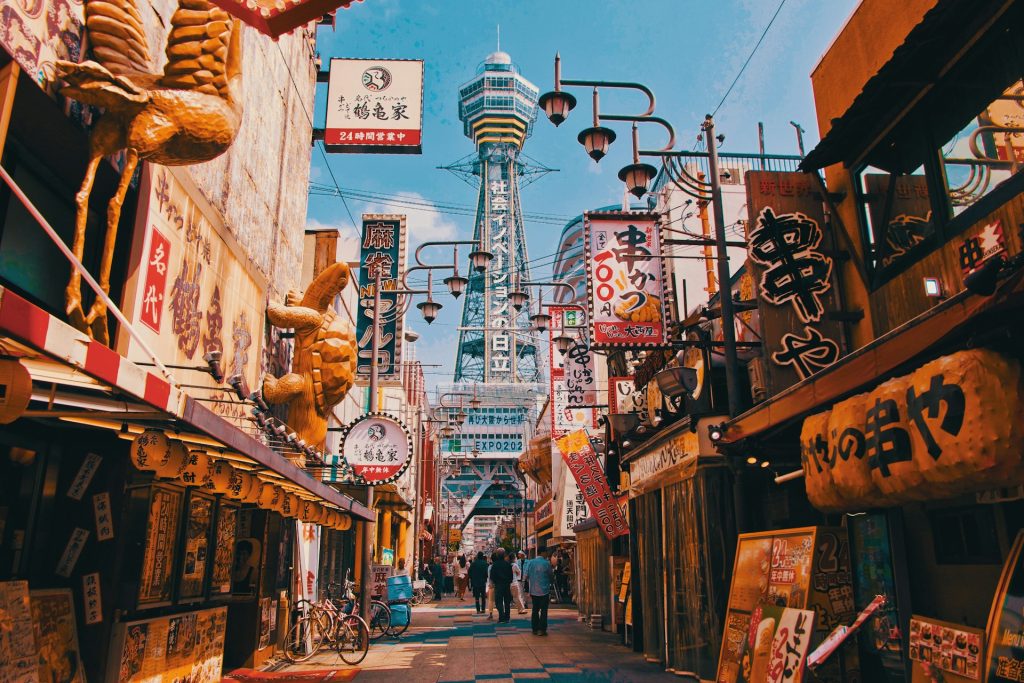
Eighth day wrap-up | Option 1:
- Osaka Castle
- Sumiyoshi Shrine
- Kuromon Market
- Dotonbori (Glico Running Man)
- Shinsaibashi-Suji
- Harukas 300
- Tsutenkaku Quarter
Where to eat in Japan – Best restaurants in Osaka
- Ichiran (ramen)
- Yakumido Curry (Japanese curry)
- Red Rock Amemura (gyudon)
- Takoyaki Juhachiban Dotonbori (takoyaki – grilled octopus balls)
- Chibo (okonomiyaki)
- 551 Horai (butaman – steamed pork buns)
- Yakitori no meimon Akiyoshi (yakitori)
- Naruto Taiyaki Hompo (taiyaki – fish-shaped waffles with a sweet red bean filling)
- Traveler’s Bar Osaka Tacos (Mexican)
- Pizza Bar Fullhouse (pizza)
Japan 8-Day Itinerary: Day 8 | Option 2 – Universal Studios Japan

As an alternative, if you prefer to bid farewell to Japan in a livelier manner, then you can take a day trip to Universal Studios Japan, the theme park from the US-based film production company. In addition to the park’s standard area, where you’ll find the most iconic attractions, as well as the music parades, Universal Studios Japan is also quite famous for its other two areas: the Wizarding World of Harry Potter, based on the adventures of the young wizard; and Super Nintendo World, inspired by the beloved franchises of the giant Japanese video game producer, such as Super Mario, Legend of Zelda or Pokémon. Fully aware of the popularity behind Super Nintendo World, the park’s management isn’t shy at all when it comes to milking this money cow… all for the sake of crowd management, of course! With that said, let’s talk about tickets. Available online via the official Universal Studios Japan website or through authorized third-party resellers (such as Klook), the price for a 1-day Studio Pass (the standard ticket) will depend on the time of the year. During quieter periods, prices can go as low as ¥8600, going up to ¥10.400 during peak times. It’s important to note that while this standard ticket grants access to all other areas of the park, it does not include entry to Super Nintendo World. If you want to gain access to this very special part of the park, you’ll need “Area Timed Entry Ticket”, an additional feature that assigns you a specific time slot to enter. To obtain this complement to the standard ticket, you have several options.
If you’re willing to take a chance and not spend any more money, you can wait until the day of your visit and request this supplement for free, either in person at the ticket booths or through the Universal Studios Japan official mobile app. However, be aware that there’s always the risk that no slots are available, especially during peak seasons. Therefore, you can play it safe and secure your entry in advance… at a steep price! The cheapest method is to purchase a Studio Pass that includes an Area Timed Entry Ticket for Nintendo World (starting from ¥12.500). However, these tickets are limited and sell out very, very quickly. Alternatively, when purchasing your ticket, you’ll need to add what they call an “Express Pass“. Essentially, this is a special pass that allows you to reduce wait times at some of the resort’s most popular attractions. It’s available in different versions, all of which include the coveted Area Timed Entry Ticket for Nintendo. The cheapest Express Pass grants you quick access to 4 rides and starts at ¥14.800, while the priciest option reduces wait times at 7 attractions, costing at least ¥19.800. Important note: this Express Pass does NOT replace the standard ticket, meaning you have to add this amount to the regular Studio Pass price!
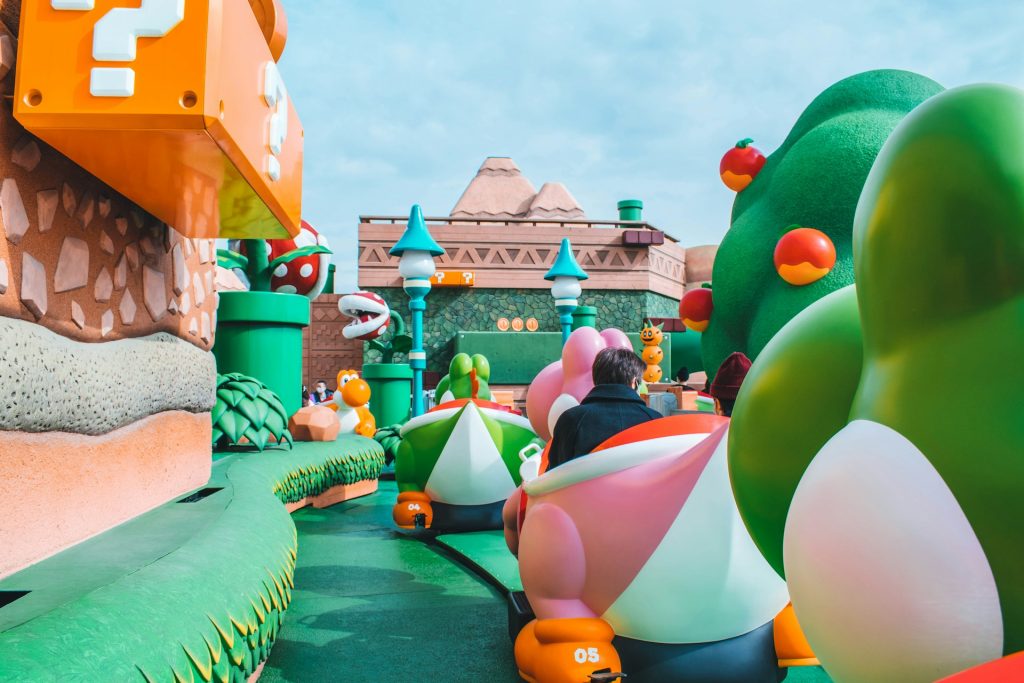
Regarding transportation, getting to the park couldn’t be easier. In this case, it’s better to stay in Kyoto for one more night and visit the park without having to worry about your bags. To get to Umeda Station, in Osaka, you can use the exact same information given for the option 1 (above), where you may then transfer to the Osaka Loop Line, operated by JR. This route goes through the city’s main stations and connects to Nishi-Kujo Station, where you can transfer to the Yumesaki Line (also JR) and get off at Universal City. Using the Umeda Station as a pinpoint, the total journey takes less than 15 minutes, with the ticket costing just ¥190. At the end of the day, you just have to do the exact same route in reverse in order to get to Kyoto. The following day, it’s time to travel all the way back to Tokyo, where your return flight awaits.
Eighth day wrap-up | Day 2:
- Universal Studios Japan
Traveling soon? Get your Holafly eSIM for seamless internet access in any destination. No more worrying about roaming charges or finding local SIM cards. Enjoy unlimited data and stay connected with ease. Order your Holafly eSIM now »
Heymondo offers a wide range of travel assistance insurance policies. They combine the best quality, service and price with various levels of coverage, so you’re covered on your weekend getaways and long trips. Buy insurance »





